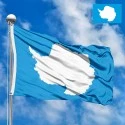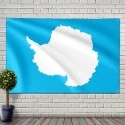Graham Bartram's proposal for the flag of Antarctica, designed in 1996, is a prominent and widely recognized symbol for the continent. This design embodies Antarctica's unique status as a territory dedicated to peace and international scientific cooperation. While it was never officially adopted, its powerful simplicity and clear symbolism have made it a significant part of the discussion around a unified identity for the world's southernmost continent.
Design and Symbolism
Graham Bartram’s proposal is celebrated for its elegant and minimalist design. It consists of a deep blue field with a pristine white silhouette of the Antarctic continent placed directly in the center.
-
The Deep Blue Field: The blue field serves a dual purpose. It represents the vast Southern Ocean that encircles Antarctica, symbolizing the continent's isolation while also highlighting the vital role of the sea as a connecting element for all nations involved in Antarctic research. The color blue is also a universal symbol of peace and neutrality, perfectly reflecting the core principles of the Antarctic Treaty System.
-
The White Silhouette: The central white silhouette represents the continent itself, with its immense and pristine ice sheet. This design choice emphasizes the singular, unifying nature of the continent. The white color is a powerful symbol of the purity of Antarctica's environment, highlighting the collective responsibility of humanity to preserve it. The map is often shown with the Antarctic Peninsula extending to the left, providing a clear and recognizable geographical reference.
History and Creation
Graham Bartram, known for his expertise in flag design and vexillology, created this proposal in 1996. His goal was to design a flag that was both aesthetically pleasing and deeply meaningful, adhering to the principles of good flag design: simplicity, distinct symbolism, and a non-political character. The flag was intended to be a common symbol that could be flown at research stations and on expeditions to represent the entire continent, transcending the flags of the individual nations present. Although the proposal received significant attention within the vexillological community and among Antarctic enthusiasts, it remained an unofficial concept.
Flag Size and Proportions
Graham Bartram's proposal typically follows the standard British flag proportions, which are 1:2 (height to width). This ratio is common in vexillology and ensures that the flag’s design is visually balanced and easily recognizable. The white silhouette of the continent is carefully scaled and centered to fill the field harmoniously, making the design stand out.
The Continent, its Status, and Meaning for its Inhabitants
Antarctica is not a country and has no permanent population. Its governance is unique, defined by the Antarctic Treaty System, which reserves the entire continent for scientific research and prohibits military activity. The flag, therefore, does not represent a state but rather an idea: a shared commitment to science, peace, and environmental protection.
For the international community of scientists, researchers, and support staff who work in Antarctica, this flag has a profound, though unofficial, meaning. It represents a unifying identity that transcends national borders. When flown, it symbolizes the camaraderie and shared mission of the people there, reminding them of their collective responsibility to protect this unique and fragile environment. The flag is a visual representation of the international cooperation that is essential for life and work on the most isolated continent.
Interesting Facts
-
Graham Bartram's 1996 design is often contrasted with other proposals for an Antarctic flag, particularly a later design that is almost identical but has a different origin story. Bartram’s version is one of the earliest to gain widespread recognition.
-
Bartram’s professional work as a vexillologist means his flag proposal was developed with a deep understanding of flag design principles, which contributes to its elegant and effective symbolism.
-
The flag's simplicity and distinct colors make it easily reproducible and recognizable from a distance, which is a crucial consideration for a flag meant to be used in a harsh polar environment.
-
The absence of any national or territorial symbols in the design is a deliberate choice, reflecting the spirit of the Antarctic Treaty and ensuring that the flag belongs to all nations and individuals who respect the continent's mission.
In summary, Graham Bartram's flag is more than just a proposal; it is a symbol of a shared vision for a continent dedicated to peace, science, and the protection of a global heritage.
In the demonstration images, full-size flags are shown with proportions of 2:3, and hand-held flags with proportions of 1:2.






 Waving flag
Waving flag
 Sizes:
Sizes:
 Round flag
Round flag
 Sizes:
Sizes:
 Rectangular flag 2:3
Rectangular flag 2:3
 Sizes:
Sizes: